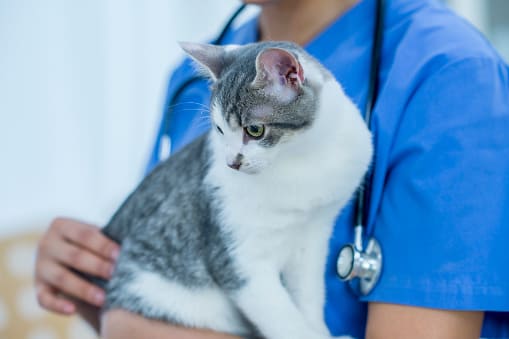
As a cat owner, it’s horrifying to visualize the one you love feline suffering from a seizure or different neurologic episode. Yet, neurological disorders can occur in cats, even as they’ll in humans. In fact, like humans, a cat’s central systema nervosum works with a posh network of nerves to send messages to the body. The brain sends signals through the spinal cord, that then travel the nerves, telling organs and muscles a way to function. once one thing within the body interferes with these signals, a spread of issues can occur. Some neurological diseases are often treated or managed with medicines, et al. with surgery.
what’s a neurologic Disorder?
neurologic disorders result from an interruption to your cat’s systema nervosum. If the difficulty is within the brain, seizures are also present. However, associate degree infection in the neural structure might lead to an unsteady gait, issues with limb functioning, or complete paralysis. an interruption of nerves will have an effect on virtually any part of your cat’s body together with its face, mouth, legs, or paws.1 And since the nervous system affects most of your cat’s major bodily functions, problems with balance, speech (meowing), eating, urinating, and defecating can also be a gift if there’s a neurologic issue present.
Symptoms of neurologic Disorders in Cats
an outsized vary of symptoms will accompany a neurological disease, reckoning on the lesion’s location and cause. However, a cat can’t tell you if she’s dizzy, disoriented, or depressed, therefore searching for physical representations of distress is crucial in diagnosis. First, there are obvious symptoms like seizures, fast blindness, an inability to steer or walk with an intoxicated gait (ataxia), or maybe partial or full palsy of the face or limb(s). Things like muscle twitch or tremors are also more durable to spot and would possibly need defrayment some quiet time learning your feline friend. note if your cat is acting disoriented or confused, encompasses abnormally speedy eye movements (nystagmus), has a head tilt, or starts walking in circles,1 as this might be an indication of one thing serious. And if you notice any of those signs, decision your veterinary to schedule a right away examination.
identification neurologic Disorders in Cats
a whole neurological analysis should be conducted at a vet’s office. First, your veterinarian can raise concerning your cat’s medical history. Then, he/she will perform a comprehensive physical examination.2 This includes checking your cat’s reflexes, inspecting its eyes, and assessing its pain. In several cases, the vet also will want to look at your cat move around.
Your vet may suggest further diagnostics, like research laboratory work, supporting the end result of the physical examination. a whole blood count, blood chemistry, and diagnosing are also ordered, and a thyroid takes a look at can rule out feline hyperthyroidism, which might generally ensue with delicate neurologic signs. Your vet might want to ascertain for top blood pressure, too.
Radiographs (x-rays) of the limbs and spine can reveal obvious issues, like spinal trauma or giant tumors within the body. Still, if your vet is unable to work out the precise reason behind the symptoms, {you may|you’ll|you can} be observed by a veterinary specialist who will review the findings associate degreed presumably suggest additional advanced imaging similar to a tomography or a CT scan to ascertain for tumors, inflammation, or different abnormalities.2 A cerebral bodily fluid faucet can also be ordered, which permits for microscopic analysis of the fluid around the spine, probably revealing the presence of infection, blood, and other abnormal cells.
Causes of neurologic Disorders
Sometimes, a vet’s examination, combined with a number of diagnostic tests, can unveil the reason behind your cat’s neurologic dysfunction. additionally, to tumors and infection, sure toxins may also have an effect on the nervous system. Infectious diseases like FIV, FeLV, or FIP can cause neurologic symptoms, too, as can some metabolic diseases.
Treatment
Treating neurological disorders in cats starts with the identification of the disorder, and care varies greatly supported the diagnosis.
- Treating seizure disorders: Seizures—sudden episodes of abnormal electrical activity within the brain—usually involve some loss of body control, similar to twitching, convulsing, and involuntary urination/defecation. Cats might have seizures for a spread of reasons however once advanced medicine reveals no precise cause, the cat is sometimes diagnosed with a brain disorder, typically managed with medication. If your cat has epilepsy, it’ vital to speak along with your vet often and come for follow-up visits once beginning a treatment protocol. reckoning on the cause, epilepsy is usually manageable with the daily administration of varied medicines.
- Treating infectious disease and encephalitis: Meningitis, inflammation of the membrane that covers the brain and spinal cord, and encephalitis, inflammation of the brain, are usually caused by infection (bacterial, viral, fungal, or parasitic). These two conditions might occur at a similar time (meningoencephalitis), and in some cases will signal a haul with a cat’ immune system. Treatment embraces the employment of corticosteroids to scale back inflammation and alter the immune system. Antibiotics, antifungals, or antiparasitic medication also are used once indicated. subsidiary care can include fluid administration, pain management, and nutritionary supplements.
- Treating proprioception malady: proprioception disease happens when the nerves that management the sensory system within the ear canals are affected inflicting lightheadedness in cats. Cats could seem drunk or dizzy, tilt their head, or show speedy abnormal eye movements. a serious ear infection or neoplasm will cause proprioception dysfunction, or meningitis, encephalitis, or encephalomeningitis can be the culprit. Treatment depends on the particular reason behind the dysfunction. If an ear infection is present, your cat may have ear drops and oral medications. subsidiary care is given once needed.
- Treating psychological feature dysfunction: psychological feature dysfunction, or insanity, is most typically seen in senior cats. Cats with dementia appear to “forget” a way to use the litter box, wherever the food bowl is, and the way to navigate through the house. there’s no cure for cognitive dysfunction, however, some medications and nutritionary supplements can help manage it.
- Treating disk malady: disk Disease (IVDD), or disc herniation, involves the inflammation or displacement of spinal discs, that ultimately place pressure on the spinal cord, resulting in pain and attainable paralysis. although additional common in dogs, IVDD will sometimes occur in cats.3 In delicate cases (when the pet can still walk), vets might strive for an approach that has rest, medication drugs, and muscle relaxants. Surgery is commonly the sole treatment for severe cases.
Treating hyperesthesia syndrome: seldom diagnosed, this condition may have an effect on a comparatively sizable amount of cats and is usually referred to as ripple skin disorder. Feline hyperesthesia is commonly mistaken for a reaction to being pet on the back, once the skin may seem to ripple or twitch. The cat may fastly scratch or overgroom the realm and have a sudden burst of energy, or different abnormal response. Hyperesthesia syndrome isn’t thought of serious and should stem from stress and anxiety. Treatment usually includes changes that scale back anxiety, similar to programming regular feeding, playtimes, and medication.
Neurologic Disorders Caused by Brain Tumors
Brain tumors will spark a myriad of problems like seizures, incoordination, blindness, and activity changes. Clinical signs rely heavily on the dimensions and site of the neoplasm. Benign tumors referred to as meningiomas will usually be removed with surgery and cats with operable meningiomas typically live traditional lives once tumor removal. while not surgical removal, however, this kind of tumor might expand, resulting in additional neurologic dysfunction.
Malignant brain tumors conjointly occur in cats. The prognosis for this type of tumor isn’t good. Palliative care can help.
a way to forestall neurologic Disorders
several neurological disorders aren’t preventable, however, maintaining a healthy manner keeps any cat in tip-top shape. Feed your cat high-quality food as counseled by your veterinarian throughout adulthood. permit it ample house to romp, play, and exercise. And invariably provide your cat love and attention.

